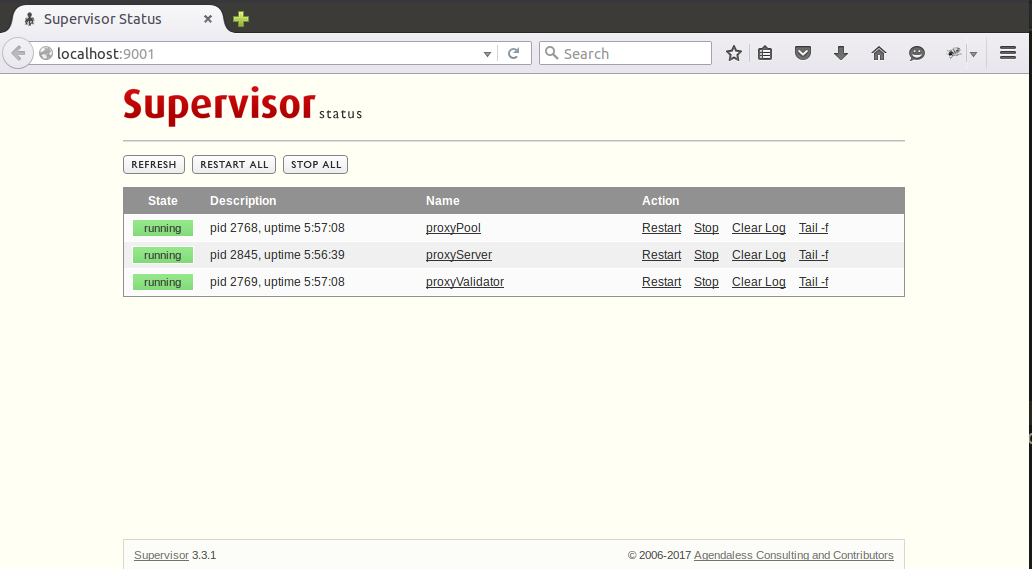Python实现的异步代理爬虫及代理池
使用python asyncio实现了一个异步代理池,根据规则爬取代理网站上的免费代理,在验证其有效后存入redis中,定期扩展代理的数量并检验池中代理的有效性,移除失效的代理。同时用aiohttp实现了一个server,其他的程序可以通过访问相应的url来从代理池中获取代理。
源码
环境
- Python 3.5+
- Redis
- PhantomJS(可选)
- Supervisord(可选)
因为代码中大量使用了asyncio的async和await语法,它们是在Python3.5中才提供的,所以最好使用Python3.5及以上的版本,我使用的是Python3.6。
依赖
- redis
- aiohttp
- bs4
- lxml
- requests
- selenium
selenium包主要是用来操作PhantomJS的。
下面来对代码进行说明。
1. 爬虫部分
核心代码
async def start(self):
for rule in self._rules:
parser = asyncio.ensure_future(self._parse_page(rule)) # 根据规则解析页面来获取代理
logger.debug('{0} crawler started'.format(rule.__rule_name__))
if not rule.use_phantomjs:
await page_download(ProxyCrawler._url_generator(rule), self._pages, self._stop_flag) # 爬取代理网站的页面
else:
await page_download_phantomjs(ProxyCrawler._url_generator(rule), self._pages,
rule.phantomjs_load_flag, self._stop_flag) # 使用PhantomJS爬取
await self._pages.join()
parser.cancel()
logger.debug('{0} crawler finished'.format(rule.__rule_name__))
上面的核心代码实际上是一个用asyncio.Queue实现的生产-消费者模型,下面是该模型的一个简单实现:
import asyncio
from random import random
async def produce(queue, n):
for x in range(1, n + 1):
print('produce ', x)
await asyncio.sleep(random())
await queue.put(x) # 向queue中放入item
async def consume(queue):
while 1:
item = await queue.get() # 等待从queue中获取item
print('consume ', item)
await asyncio.sleep(random())
queue.task_done() # 通知queue当前item处理完毕
async def run(n):
queue = asyncio.Queue()
consumer = asyncio.ensure_future(consume(queue))
await produce(queue, n) # 等待生产者结束
await queue.join() # 阻塞直到queue不为空
consumer.cancel() # 取消消费者任务,否则它会一直阻塞在get方法处
def aio_queue_run(n):
loop = asyncio.get_event_loop()
try:
loop.run_until_complete(run(n)) # 持续运行event loop直到任务run(n)结束
finally:
loop.close()
if __name__ == '__main__':
aio_queue_run(5)
运行上面的代码,一种可能的输出如下:
produce 1
produce 2
consume 1
produce 3
produce 4
consume 2
produce 5
consume 3
consume 4
consume 5爬取页面
async def page_download(urls, pages, flag):
url_generator = urls
async with aiohttp.ClientSession() as session:
for url in url_generator:
if flag.is_set():
break
await asyncio.sleep(uniform(delay - 0.5, delay + 1))
logger.debug('crawling proxy web page {0}'.format(url))
try:
async with session.get(url, headers=headers, timeout=10) as response:
page = await response.text()
parsed = html.fromstring(decode_html(page)) # 使用bs4来辅助lxml解码网页:http://lxml.de/elementsoup.html#Using only the encoding detection
await pages.put(parsed)
url_generator.send(parsed) # 根据当前页面来获取下一页的地址
except StopIteration:
break
except asyncio.TimeoutError:
logger.error('crawling {0} timeout'.format(url))
continue # TODO: use a proxy
except Exception as e:
logger.error(e)
使用aiohttp实现的网页爬取函数,大部分代理网站都可以使用上面的方法来爬取,对于使用js动态生成页面的网站可以使用selenium控制PhantomJS来爬取――本项目对爬虫的效率要求不高,代理网站的更新频率是有限的,不需要频繁的爬取,完全可以使用PhantomJS。
解析代理
最简单的莫过于用xpath来解析代理了,使用Chrome浏览器的话,直接通过右键就能获得选中的页面元素的xpath:

安装Chrome的扩展"XPath Helper"就可以直接在页面上运行和调试xpath,十分方便:

BeautifulSoup不支持xpath,使用lxml来解析页面,代码如下:
async def _parse_proxy(self, rule, page):
ips = page.xpath(rule.ip_xpath) # 根据xpath解析得到list类型的ip地址集合
ports = page.xpath(rule.port_xpath) # 根据xpath解析得到list类型的ip地址集合
if not ips or not ports:
logger.warning('{2} crawler could not get ip(len={0}) or port(len={1}), please check the xpaths or network'.
format(len(ips), len(ports), rule.__rule_name__))
return
proxies = map(lambda x, y: '{0}:{1}'.format(x.text.strip(), y.text.strip()), ips, ports)
if rule.filters: # 根据过滤字段来过滤代理,如"高匿"、"透明"等
filters = []
for i, ft in enumerate(rule.filters_xpath):
field = page.xpath(ft)
if not field:
logger.warning('{1} crawler could not get {0} field, please check the filter xpath'.
format(rule.filters[i], rule.__rule_name__))
continue
filters.append(map(lambda x: x.text.strip(), field))
filters = zip(*filters)
selector = map(lambda x: x == rule.filters, filters)
proxies = compress(proxies, selector)
for proxy in proxies:
await self._proxies.put(proxy) # 解析后的代理放入asyncio.Queue中
爬虫规则
网站爬取、代理解析、滤等等操作的规则都是由各个代理网站的规则类定义的,使用元类和基类来管理规则类。基类定义如下:
class CrawlerRuleBase(object, metaclass=CrawlerRuleMeta):
start_url = None
page_count = 0
urls_format = None
next_page_xpath = None
next_page_host = ''
use_phantomjs = False
phantomjs_load_flag = None
filters = ()
ip_xpath = None
port_xpath = None
filters_xpath = ()
各个参数的含义如下:
start_url(必需)
爬虫的起始页面。
ip_xpath(必需)
爬取IP的xpath规则。
port_xpath(必需)
爬取端口号的xpath规则。
page_count
爬取的页面数量。
urls_format
页面地址的格式字符串,通过urls_format.format(start_url, n)来生成第n页的地址,这是比较常见的页面地址格式。
next_page_xpath,next_page_host
由xpath规则来获取下一页的url(常见的是相对路径),结合host得到下一页的地址:next_page_host + url。
use_phantomjs,phantomjs_load_flag
use_phantomjs用于标识爬取该网站是否需要使用PhantomJS,若使用,需定义phantomjs_load_flag(网页上的某个元素,str类型)作为PhantomJS页面加载完毕的标志。
filters
过滤字段集合,可迭代类型。用于过滤代理。
爬取各个过滤字段的xpath规则,与过滤字段按顺序一一对应。
元类CrawlerRuleMeta用于管理规则类的定义,如:如果定义use_phantomjs=True,则必须定义phantomjs_load_flag,否则会抛出异常,不在此赘述。
目前已经实现的规则有西刺代理、快代理、360代理、66代理和 秘密代理。新增规则类也很简单,通过继承CrawlerRuleBase来定义新的规则类YourRuleClass,放在proxypool/rules目录下,并在该目录下的init.py中添加from . import YourRuleClass(这样通过CrawlerRuleBase.subclasses()就可以获取全部的规则类了),重启正在运行的proxy pool即可应用新的规则。
2. 检验部分
免费的代理虽然多,但是可用的却不多,所以爬取到代理后需要对其进行检验,有效的代理才能放入代理池中,而代理也是有时效性的,还要定期对池中的代理进行检验,及时移除失效的代理。
这部分就很简单了,使用aiohttp通过代理来访问某个网站,若超时,则说明代理无效。
async def validate(self, proxies):
logger.debug('validator started')
while 1:
proxy = await proxies.get()
async with aiohttp.ClientSession() as session:
try:
real_proxy = 'http://' + proxy
async with session.get(self.validate_url, proxy=real_proxy, timeout=validate_timeout) as resp:
self._conn.put(proxy)
except Exception as e:
logger.error(e)
proxies.task_done()3. server部分
使用aiohttp实现了一个web server,启动后,访问http://host:port即可显示主页:

- 访问http://host:port/get来从代理池获取1个代理,如:'127.0.0.1:1080';
- 访问http://host:port/get/n来从代理池获取n个代理,如:"['127.0.0.1:1080', '127.0.0.1:443', '127.0.0.1:80']";
- 访问http://host:port/count来获取代理池的容量,如:'42'。
因为主页是一个静态的html页面,为避免每来一个访问主页的请求都要打开、读取以及关闭该html文件的开销,将其缓存到了redis中,通过html文件的修改时间来判断其是否被修改过,如果修改时间与redis缓存的修改时间不同,则认为html文件被修改了,则重新读取文件,并更新缓存,否则从redis中获取主页的内容。
返回代理是通过aiohttp.web.Response(text=ip.decode('utf-8'))实现的,text要求str类型,而从redis中获取到的是bytes类型,需要进行转换。返回的多个代理,使用eval即可转换为list类型。
返回主页则不同,是通过aiohttp.web.Response(body=main_page_cache, content_type='text/html'),这里body要求的是bytes类型,直接将从redis获取的缓存返回即可,conten_type='text/html'必不可少,否则无法通过浏览器加载主页,而是会将主页下载下来――在运行官方文档中的示例代码的时候也要注意这点,那些示例代码基本上都没有设置content_type。
这部分不复杂,注意上面提到的几点,而关于主页使用的静态资源文件的路径,可以参考之前的博客《aiohttp之添加静态资源路径》。
4. 运行
将整个代理池的功能分成了3个独立的部分:
proxypool
定期检查代理池容量,若低于下限则启动代理爬虫并对代理检验,通过检验的爬虫放入代理池,达到规定的数量则停止爬虫。
proxyvalidator
用于定期检验代理池中的代理,移除失效代理。
proxyserver
启动server。
这3个独立的任务通过3个进程来运行,在Linux下可以使用supervisod来=管理这些进程,下面是supervisord的配置文件示例:
; supervisord.conf
[unix_http_server]
file=/tmp/supervisor.sock
[inet_http_server]
port=127.0.0.1:9001
[supervisord]
logfile=/tmp/supervisord.log
logfile_maxbytes=5MB
logfile_backups=10
loglevel=debug
pidfile=/tmp/supervisord.pid
nodaemon=false
minfds=1024
minprocs=200
[rpcinterface:supervisor]
supervisor.rpcinterface_factory = supervisor.rpcinterface:make_main_rpcinterface
[supervisorctl]
serverurl=unix:///tmp/supervisor.sock
[program:proxyPool]
command=python /path/to/ProxyPool/run_proxypool.py
redirect_stderr=true
stdout_logfile=NONE
[program:proxyValidator]
command=python /path/to/ProxyPool/run_proxyvalidator.py
redirect_stderr=true
stdout_logfile=NONE
[program:proxyServer]
command=python /path/to/ProxyPool/run_proxyserver.py
autostart=false
redirect_stderr=true
stdout_logfile=NONE
因为项目自身已经配置了日志,所以这里就不需要再用supervisord捕获stdout和stderr了。通过supervisord -c supervisord.conf启动supervisord,proxyPool和proxyServer则会随之自动启动,proxyServer需要手动启动,访问http://127.0.0.1:9001即可通过网页来管理这3个进程了:

supervisod的官方文档说目前(版本3.3.1)不支持python3,但是我在使用过程中没有发现什么问题,可能也是由于我并没有使用supervisord的复杂功能,只是把它当作了一个简单的进程状态监控和启停工具了。
以上就是本文的全部内容,希望本文的内容对大家的学习或者工作能带来一定的帮助,同时也希望多多支持脚本之家!